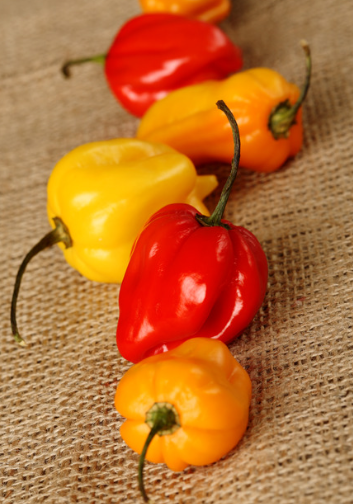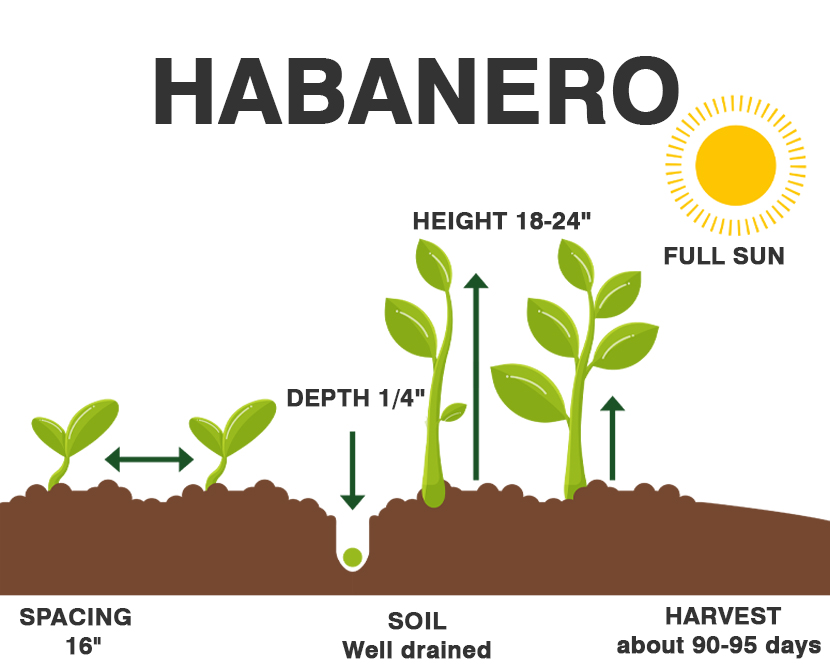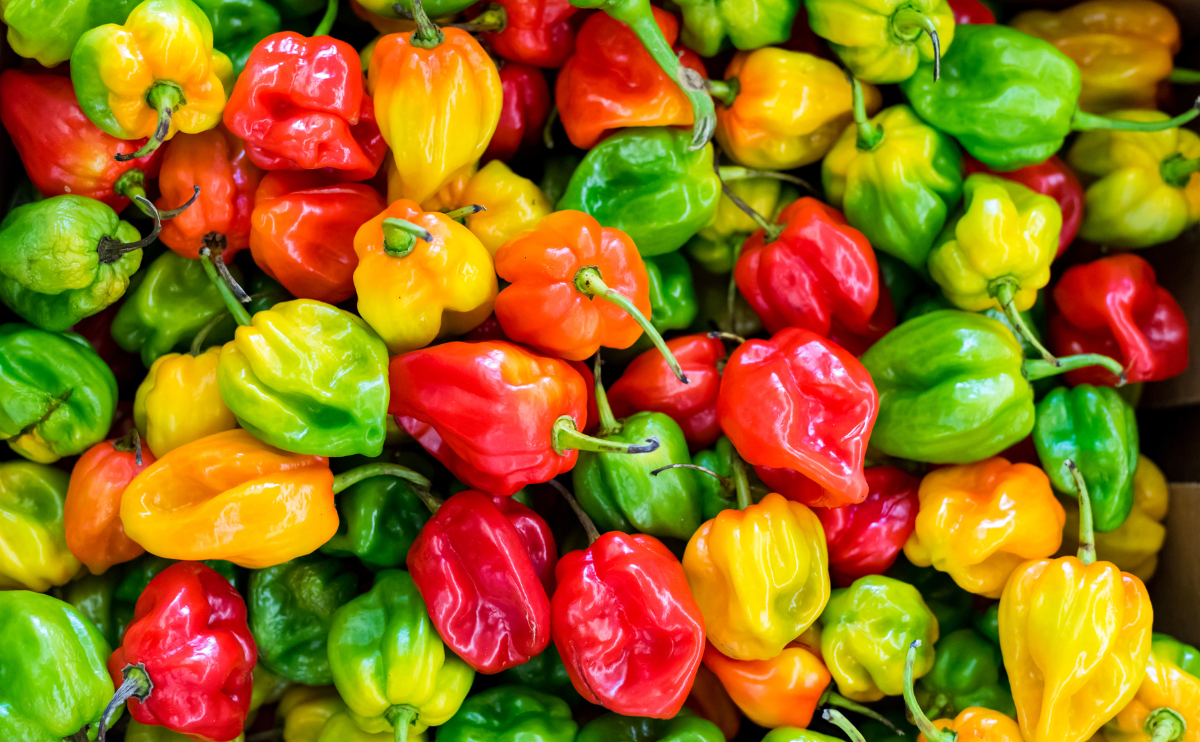At one point, the habanero (100,000 to 350,000 Scoville heat units or SHU) held the crown as the world’s hottest chili pepper, but don’t let the fact that certain chilies have passed it by fool you into underestimating it. This is a seriously hot pepper. And unlike many of the hotter chilies, there’s quite a bit of flavor to go along with the extra-hot kick. it has a unique, citrus-like taste with a subtle hint of smoke that makes it very popular in hot sauces, powders, and rubs. If you can handle the heat, this is a fun culinary chili to play with in the kitchen.

| Common Name | Habanero pepper |
| Botanical Name | Capsicum annuum ‘Habanero’ |
| Family | Solanaceae |
| Plant Type | Perennial, vegetable |
| Size | 1–4 ft. tall, 1–2 ft. wide |
| Sun Exposure | Full sun |
| Soil Type | Moist, well-drained |
| Soil pH | Acidic, neutral |
| Bloom Time | Summer |
| Hardiness Zones | 9–11 (USDA) |

When to Plant?
This will be determined by your planting zone. There is a final frost date for each area. As a result, you can plan your gardening activities around this date. Check our Frost Dates Across North America: First & Last Frost Dates Chart. However, the date will not be the same for every plant.
How to Plant
Pepper should be started indoor approximately 8 weeks prior to the last frost of the spring.
Sow ¼” deep in a well-drained starting medium. Seeds require lots of warmth to germinate; the medium should be between 80-85 °F. Using a heat mat, available at home and garden store, and elsewhere, can help to ensure ideal conditions. Additionally, young starts will fare much better with additional light. Place in a window or sunny location that receives lots of southern or southwestern sun exposure. Consider supplementing with artificial lighting if possible.

Set plants out 2 to 3 weeks after the average last frost, when the soil has warmed and the weather has settled. Peppers can be temperamental when it comes to setting fruit if temperatures are too hot or too cool. Nighttime temperatures below 60 °F or above 75 F can reduce fruit set.
Plant them 12 to 24 inches apart, in rows 24 to 36 inches apart, or spaced about 14 to 16 inches apart in raised beds.
Select a location that receives plenty of light and heat, and has not been used for tomatoes, potatoes, or other members of this family for several years. Peppers will do best with soil that is fertile, lightweight, slightly acidic (pH5.5-7.0), and well-drained.
Wait until soil temperatures exceed 50 °F at all times before placing into the ground. Pepper plants should be fairly close to one another, so that there is slight contact between plants.
How to Cultivate
Wait to water the soil until it dries out completely to avoid soggy roots. This is usually every 2-3 days if the plant is getting lots of sunlight. When you touch the soil, and it’s dry, water the plant thoroughly by soaking it and letting the excess water drain out. Overwatering your habanero can lead to the plant getting diseases or tasting super bitter.
Fertilize your habanero once it’s 6 weeks old. After about a month and a half, your plant is mature enough to handle fertilizer. Choose a fertilizer that doesn’t have too much nitrogen and that’s organic. Follow the instructions on the fertilizer, so you know how often to give it to the habanero, as well as how much to use. Try using 11-3-8 mix fertilizer on your habanero.
Some fertilizers recommend that you use them once every 2 weeks.
Get rid of pests on your outdoor plant using insecticidal soap. Most pests don’t tend to go towards habanero plants, but if you do see some bugs on your plant, apply insecticidal soap to help get rid of them. Another option is spraying the plant with a hose to wash the bugs off.
Purchase an insecticidal soap at your local home improvement or gardening store. Insecticidal soaps won’t harm you or most animals if it’s ingested (but you should wash off your peppers with clean water once you pick them!).
Prune the shoots if you want a bushier habanero plant. Pruning your habanero plant isn’t required, but it’s a good way to give your plant a fuller shape while encouraging pepper production. Trim the shoots where the leaves begin to branch out using a pair of gardening shears or clean scissors right at the base of the node.
The node is the part of the plant where the leaves, stems, or flowers sprout and grow.
Use your fingers to pinch off the flowers, so the plant focuses its energy on the peppers.
Check your peppers for signs of splitting apart due to too much sun. While habanero plants love sunlight and thrive in it, too much direct harsh sunlight can cause sun scald, which is essentially when the plant gets burned. Sun scald is when the peppers start to split due to the heat.
Most plants that are getting at least 6 hours of normal sunlight each day will be okay. Your plant’s leaves will help protect the fruit from sun scald. Bring your habanero plant indoors once the weather turns cold. Your plant won’t last outdoors in the cold weather. To preserve it, bring it inside easily if it’s already in a pot or fill a pot with soil and dig up the roots carefully to bring your habanero plant indoors if it was in the ground.
During the colder months, you won’t need to water your habanero plant as much.
How to Harvest
Peppers will turn green when starting to approach maturity. They can be harvested at this point, or allowed to ripen on the plant. If collected early, plants will continue to flower and fruit more frequently, though this early collection might result in differences in flavor if used fresh.
Use scissors or snip to cut branches and harvest peppers. Do not remove by hand as plants can be easily damaged.
Hydroponics
Germination: To germinate Habanero pepper seeds hydroponically, soak them in warm water for 24 hours, plant them 1/4 inch deep in a small container filled with seedling mix, and keep the soil moist with consistent warmth and light. Germination should occur within 7-10 days.
pH range: The optimal pH range for growing Habanero pepper hydroponically is between 5.5 and 6.5. You can use a pH meter or pH testing strips to monitor the pH levels of your hydroponic system.
EC: The electrical conductivity (EC) for Habanero pepper hydroponic systems is between 1.5 and 2.5 mS/cm. It’s important to regularly check the EC levels of your hydroponic system and make adjustments as needed to maintain this range.
PPM: The ideal parts per million (PPM) for Habanero pepper hydroponic systems is between 700 and 1000 ppm.
Humidity: Habanero peppers prefer a relative humidity (RH) of around 50-60% during the vegetative stage and 40-50% during the flowering stage.
Light hours: The plant require at least 12-14 hours of light per day during the vegetative stage and 8-12 hours of light per day during the flowering stage. You can use a grow light or natural sunlight to provide the necessary light.
Temperature air: Habanero peppers thrive in warm temperatures, with an optimal range of 75-85°F (24-29°C) during the day and 65-75°F (18-24°C) at night.
Temperature water: The water temperature for your hydroponic system should be kept between 65-75°F (18-24°C). You can use a water heater or chiller to maintain the appropriate temperature.
Overall, growing Habanero pepper hydroponically can be a rewarding experience, and following these guidelines can help you grow healthy and vibrant plants.



